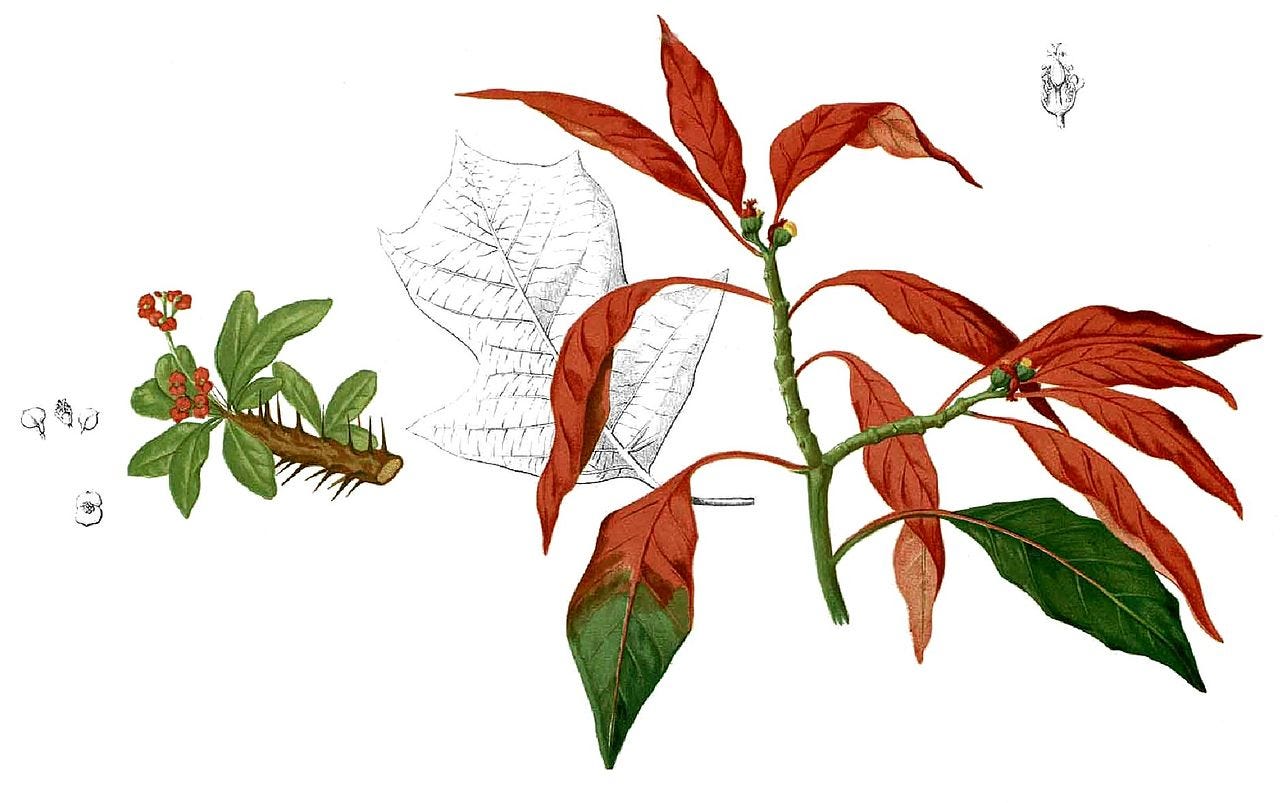When I think of Euphorbiaceae, and who doesn’t, what comes to mind are those with fleshy leaves that remind me of a cactus. But many are herbs, shrubs and trees. It’s a large, widespread family of about 7,500 species found on every continent except Antarctica, and present in the fossil record since about 66 million years ago.
The poinsettia. Euphorbia pulcherrima. Illustration ca. 1880, Francisco Manuel Blanco, Flora de Filipinas. Public domain.
Today, we focus on a familiar species. Collected on an expedition to Mexico in 1803-1804 by von Humboldt and Bonpland, this new species was later named Euphorbia pulcherrima. Its native range is Mexico from Sinaloa south to Chiapas and Guatemala, in mid-elevation, dry tropical forests. The Aztecs used the plant to produce a red dye, and as a medicine to treat fevers. The plant has several common names: the painted leaf, the Mexican flame flower, and the flor de nochebuena. You may know it as the poinsettia.
As a student collecting beetles in Panama, somewhere in the volcanic range bordering Costa Rica, I walked through a village and was surprised to see a small tree, perhaps ten feet in height, covered with an unmistakable display of bright red. I was used to the potted poinsettias we enjoy at Christmastime and had not known that it is actually a shrub or tree. What is most striking, of course, are the brilliantly colored bracts — available in a range of colors among the more than 100 cultivated varieties, including white, pink and pale green. Many people mistake the bracts for flowers, but they are actually modified leaves. Don’t feel bad if you were fooled, there are insect pollinators that make the same mistake. The actual flowers are small and frankly unimpressive by comparison.
Around 1919, a two-year-old child was reported to have died after eating a poinsettia leaf and an urban legend was born. Like they say, a lies is halfway around the world before the truth can get its pants on. And in spite of having been debunked, this myth persists. Lab rats were given the chemical equivalent of eating 500 leaves and did not die. Poinsettias can induce diarrhea, nausea vomiting, a skin rash, eye irritation, or an asthma attack, but it is not nearly so dangerous as its reputation. Of more than 20,000 telephone calls to poison control centers between 1985 and 1992, not a single incident resulted in a fatality. The same is largely true for cats and dogs for which poinsettias are mildly toxic. So, relax, have a cup of eggnog, and enjoy that colorful stunted tree in the flower pot.
Did you ever wonder why they’re called poinsettias? That common name traces to a physician, diplomat, and amateur botanist who sent poinsettias from Mexico to his greenhouse in South Carolina, introducing them to the U.S. When President James Monroe was worried about the stability of a newly independent Mexico, he sent him as a special envoy. Then President John Quincy Adams appointed him Minister to Mexico. In 1828, he signed a treaty with Mexico that recognized the border with the U.S. as it had been established by an earlier treaty between Spain and the U.S. And he also served as President Martin van Buren’s secretary of war. He was co-founder of the National Institute for the Promotion of Science and the Useful Arts in 1840, a group of politicians who advocated for the generous Smithson bequest to the U.S. to be used to establish a national museum to showcase the country and its leaders. Ultimately — and in my view, thankfully — his vision lost out to another that wanted scientists guiding the founding of the institution we now know as the Smithsonian.
Poinsettias became popular in the U.S. in the early 19th century, after they were exhibited by the Pennsylvania Horticultural Society at the Philadelphia Flower show in 1829. By 1836, the name poinsettia was in common use. Today, the poinsettia generates more money than any other potted plant. In the U.S. alone, about 70 million plants are sold over a six-week period leading up to Christmas.
We can thank the Ecke family for expanding the close association of poinsettias to Christmas. They developed a closely guarded grafting technique that produced the attractive, full plants we see today, rather than the spindly natural ones, and they were superb marketers, donating poinsettias to television stage sets and appearing on the Tonight Show and the Bob Hope special to promote them. Someone eventually worked out and published the grafting technique, but the family business still provides about 70% of the plants in the U.S., and 50% to the world market.
Oh, the name of this diplomat, physician, and sometimes botanist? It was Joel Roberts Poinsett. And, as Paul Harvey would have said, now you know the rest of the story.
From the Species Hall of Fame a very Merry Christmas and Happy Holidays.
Further Reading
Chandler, C.L. and Smith, R. (1935). The Life of Joel Roberts Poinsett. The Pennsylvania Magazine of History and Biography. 59 (1): 1–31.
Hendry, E.R. (2013) How America’s most popular potted plant captured Christmas. Smithsonian Magazine, 12 December.
National Capital Poison Control Center. Are poinsettias poisonous? https://www.poison.org/articles/poinsettias
Rippy, F.J. (1935) Joel R. Poinsett: Versatile American. Durham: Duke University Press.




